
Regular readers of The Beat know me as the comic BOOK guy. I’m a bookseller, a librarian, a comics evangelist, and, yes, a seeker of the esoteric. So that means while people (and websites) cover the comics industry, I’m usually wandering off to some strange corner, discovering something cool that no one else knows about.
I’m also a bit of a recreational mathematician, a numbers wonk, and while others run Fantasy Football leagues, I’m over at Massey Ratings checking in on all 916 college football teams!
So, we talk a lot here at The Beat about sales charts, the Top 300 this-and-that, and how big the slices are (and how bigger the pie itself is growing).
One of the most famous rankings in bookselling, and one of the oldest, are the weekly bestsellers as charted by the New York Times newspaper. After a bit of controversy over the non-listing of Watchmen in the Summer of 2008 (although the novelization of “The Dark Knight” did get listed), the Times instituted three bestseller charts for “graphic books”. (Yeah… it’s awkward… but nobody notices that.) So, in March 2009, the list was introduced, and various creators have been able to list “New York Times bestselling author” on their press releases!
I offered a multi-part analysis here last year, and I’ll just do one this year, since I’m sure many really aren’t that interested. It’ll be long, but there will be lost of pie charts! Everyone loves pie, right? Click on any graphic to make it larger!
The Executive Summary:
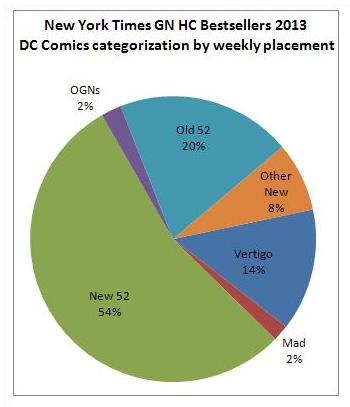
Image dominated the trade paperback list, thanks to The Walking Dead juggernaut. However, about 2/3 of their success on that list was a result of that one series, which could be a weakness if the television series ever ends. Saga had a strong showing with the first two collections, charting multiple weeks and continuing to sell. Other titles appeared for one or two weeks, and vanished to the backlist, although if one of those titles gains a following similar to TWD or Saga, then history could repeat.
Over in manga, it was all about Attack on Titan. Volume One made a brief appearance on last year’s list, and then went into the usual hibernation seen with most manga series. Then, in July, it reappeared with Volume 5 charting, and then exploded, with almost every volume (Volume 1, 2, 3, 4, 5, 7) charting simultaneously on November 3! Two volumes of a series is unusual. Six? Unprecedented! Kodansha moved to monthly publication in August, so this series will continue to sell, especially with ancillary titles scheduled for 2014!
Hardcovers
So… what sold well in hardcover? It’s a difficult market… comics shops take on more more risk with a hardcover book, which some frugal fans tend to avoid, or purchase cheaper online. Many hardcovers also fall outside the normal customer base of comics shops, aimed more at the art or literary comics reader.
That said, DC dominated the #1 spot, with 27 placements. But what were their hits? Well, though it’s officially published by Oxmoor (the publishing division of Time/Life Video), “Totally Mad: 60 Years of Humor, Satire, Stupidity and Stupidity” charted well during the Holiday 2012 season. I would guess all of those sales occurred outside of comics shops. The Batman family of titles sold well, encouraged by a strong marketing campaign featuring the Joker and the Death of the Family. The rest of DC’s output charted at least one week (a few charted for four weeks), which included original graphic novels by Harlan Ellison and Anthony Bourdain. The Absolute and Deluxe editions charted, proving that some titles are immune from the sticker shock experienced by fans. The controversial “Before Watchmen” collections charted well, with a few at #1, but they didn’t last long. Will there be a life in backlist, riding the coattails of the original graphic novel? It remains to be seen.
Surprisingly, Random House was second, with 11 weeks at #. What did they publish? Well, they started the year with “Building Stories”, an expensive, audacious, experimental box set of 14 separate items. It dominated the #1 spot for seven straight weeks (not counting sales in 2012)! Habibi made a brief appearance (probably buoyed by ‘Year’s Best’ listings). In backlist, Spiegelman and Satrapi sold nicely, due to collegiate reading lists. Game of Thrones hit #1 for a few weeks in July, and continued to chart through the summer. Little noticed in the comics community, “Mission in a Bottle”, a business profile of the Honest Tea brand, debuted at #1 and held that spot for two weeks, charting for seven. Overall they ranked fourth for the year, but they are also the book trade distributor for DC Comics AND Kodansha, so they had a VERY good year!)
The others? Marvel actually managed 59 placements on the hardcover chart, a paltry showing to DC’s 217! Wondering how that compares to last year? Then, Marvel had… 58.5 placements in HC, to DC’s 196. Image doesn’t have a strong hardcover list, and dropped from 87 placements to 52. There isn’t a lot of The Walking Dead appearing on the list this year…that market seems to have moved to the massive paperback compendiums (see below!).
Legendary Comics had a sleeper hit with a Pacific Rim tie-in, and Dark Horse has great success with “The Fifth Beatle”, a beautiful and moving biography of the Beatles’ manager, Brian Epstein. (Expect more interest next month, as the press celebrates the 50th anniversary of their appearance on The Ed Sullivan Show!)
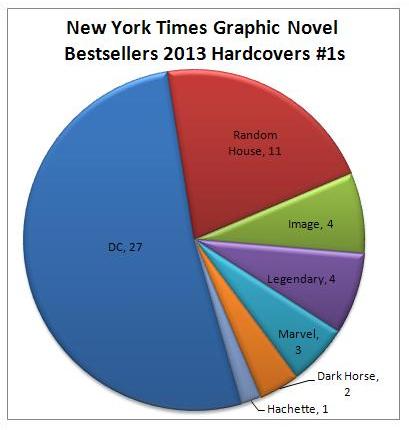
- Building Stories (Random House) [seven weeks]
- Justice League, Volume 2 [two weeks]
- Batman: Night of Owls
- Fables – The Deluxe Edition Book Six
- The Sleeper Omnibus
- Kick-Ass 2 Prelude: Hit-Girl
- Earth 2, Volume 1
- Batman, Volume 2 [four weeks]
- Detective Comics, Volume 2
- Twilight: New Moon, Volume 1
- Action Comics, Volume 2
- Batman, Incorporated, Volume 1 [two weeks]
- Aquaman, Volume 2
- The New Teen Titans Omnibus, Volume 3
- A Game of Thrones, Volume 2 (Random House) [two weeks]
- Pacific Rim: Tales From Zero Year (Legendary) [four weeks]
- Before Watchmen: Minutemen/Silk Spectre
- Daredevil: End of Days (Marvel)
- Before Watchmen: Comedian/Rorschach
- The Animal Man Omnibus [two weeks]
- The Flash, Volume 2
- Mission in a Bottle (Random House) [two weeks]
- The Walking Dead, Book 9 (Image) [four weeks]
- Justice League, Volume 3
- The Joker: Death of the Family
- Batgirl, Volume 3
- Batman, Volume 3 [three weeks]
- Fairest: In All the Land
- The Fifth Beatle: The Brian Epstein Story (Dark Horse) [two weeks]
 Trade Paperbacks
Trade Paperbacks
Where DC dominated in hardcover, Image dominated in trade paperbacks, with 29 weeks at #1, and a third of all titles charting during 2013! Of those #1 titles, the two compendiums for The Walking Dead (each containing 48 issues!) dominated, with Volume One appearing for 18 weeks, and Volume Two for an additional two. When they weren’t at #1, they still charted. By year’s end, TWDC1 had been on the charts for 113 weeks, and TWDC2 for 47! It was not unusual to see the two volumes listed at #1 and #2 on the same week!)
The other Number One titles for Image: TWD, Volume 1; Saga, Volume 2; TWD, Volume 13; TWD, Volume 19.
As mentioned earlier, Image has great success with TWD. However, as seen on the chart above, it accounts for 2/3 of Image’s placement on the paperback chart. It’s a weakness that I’m sure Image is cognizant of. While they had a great year both financially and critically, the future eventually shows an end to the success of The Walking Dead television series. Image needs to channel their resources into developing new series which can become franchises. Saga is already a massive success, with Volume Three having a strict-on-sale date scheduled, usually reserved for bestsellers. Chew did chart briefly, and has an elevator pitch almost as elegant and seductive as Saga’s “Romeo and Juliet meets Star Wars”! Manhattan Projects is gonzo science fiction, and also easy to pitch. Some creative marketing outside the comics community can create viral word-of-mouth which would generate sales. (Start with World Con.)
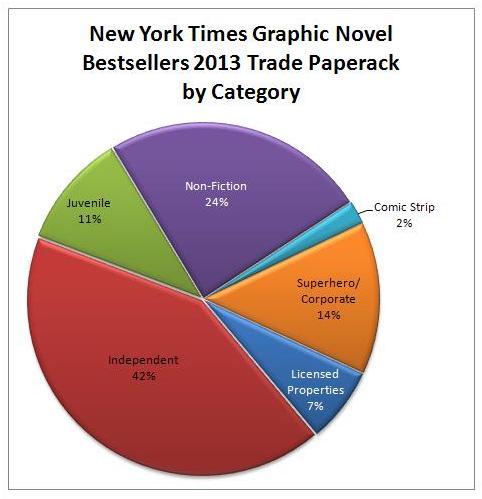
DC saw its slice shrink from 125 placements in 2012 to 66 in 2013! They had only two #1 titles: Fable, Volume 18; Batman, Volume 2. As with the hardcover titles, most of their releases charted, but not for long.
Random House had success with their backlist, as Persepolis and Maus sold perennially to college students. (I suspect the same can be said for Watchmen.)
Kids titles are a strong market. In addition to Scholastic, Dark Horse had great success with their Last Airbender franchise (is the cartoon still on tv?), and Papercutz continues to print money with their Lego Ninjago license.
Marvel did much better, gaining five placements, and gaining two #1s with Hawkeye. A few licensee titles (Dark Tower, Once Upon A Time) charted, but only Hawkeye and Deadpool stayed on the list for more than one week.
Top Shelf, after six months of incredible marketing, dominated the Fall season with “March, Book One”. By the end of the year, it had charted for 18 weeks, and I expect to see it become a backlist perennial as it gets added to reading lists.
Andrews McMeel charted well with a variety of comic strip collections.
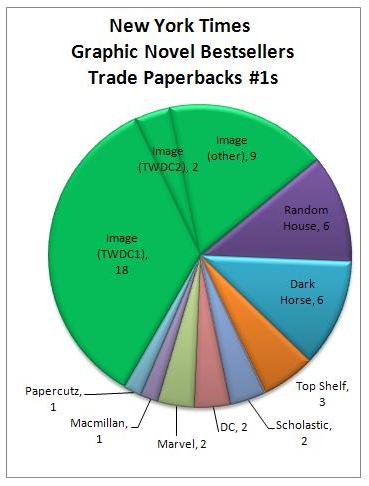
- The Walking Dead Compendium, Volume 1 [eighteen weeks]
- The Walking Dead Compendium, Volume 2 [two weeks]
- Drama (Scholastic) [two weeks]
- Persepolis (Random House) [five weeks]
- Fables, Volume 18 (DC Comics)
- The Walking Dead, Volume 1
- Hawkeye, Volume 1 (Marvel)
- Avatar: The Last Airbender, Part 2 (Dark Horse) [five weeks]
- Lego Ninjago #7, Stone Cold
- The Walking Dead, Volume 18
- Saga, Volume 2 [four weeks]
- Hawkeye, Volume 2 (Marvel)
- March: Book One (Top Shelf) [three weeks]
- Maus: A Survivor’s Tale, Volume 1 (Random House)
- Battling Boy (Macmillan)
- Batman, Volume 2 (DC Comics)
- Avatar: The Last Airbender: The Search, Part 3 (Dark Horse)
- The Walking Dead, Volume 13
- The Walking Dead, Volume 19
Manga
Not as much to report here…
Let’s start with the big chart!
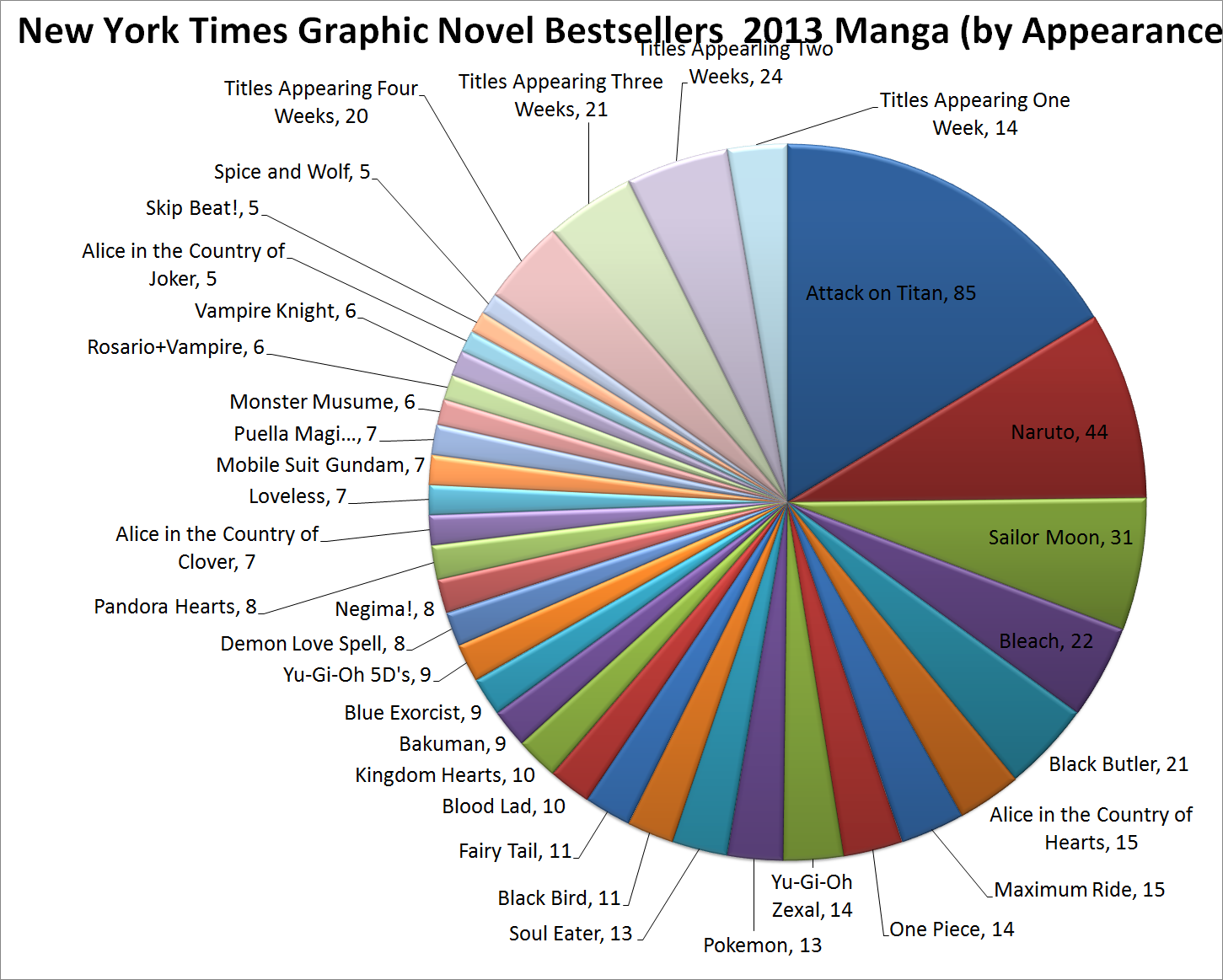
As you can see from those last four slices, the manga market is extremely competitive. It is rare for a title to last more than four weeks. If it does, it should be considered a franchise, like Naruto or Sailor Moon.
Why is it so volatile? I suspect a lot of it is due to pre-ordering. You love a title. You can’t wait for the next volume to ship. So you pre-order it online or at a bookstore, and await instant notification when it ships. As soon as it ships, the numbers are counted as “sales” and get reported. (The same happens with regular prose bestsellers, as a fan feeding frenzy occurs with each new title.)
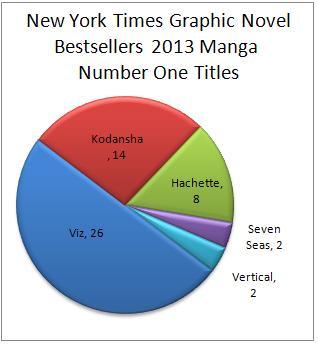
- Maximum Ride, Volume 6 (Hachette/Yen) [three weeks]
- Bleach, Volume 54 (Viz Media)
- Missions of Love, Volume 2 (Kodansha)
- Black Butler, Volume 12 (Yen)
- Sailor Moon, Volume 9 (Kodansha)
- Naruto, Volume 60 (Viz) [two weeks]
- Skip Beat, Volume 30 (Viz)
- Battle Angel Alita: Last Order, Volume 17 (Kodansha)
- Rosario+Vampire Season III, Volume 11 (Viz)
- One Piece, Volume 66 (Viz)
- Yu-Gi-Oh! Zexal, Volume 2 (Viz)
- Sailor Moon, Volume 10 (Kodansha) [two weeks]
- Bleach, Volume 56 (Viz) [two weeks]
- Negima Magister Negi Magi, Volume 38 (Kodansha)
- Naruto, Volume 61 (Viz) [two weeks]
- Sailor Moon, Volume 11 (Kodansha) [two weeks]
Yu-Gi-Oh! Zexal, Volume 3 (Viz) [two weeks]
- One Piece, Volume 67 (Viz)
- Mobile Suit Gundam: The Origin, Volume 2 (Vertical)
- Bleach, Volume 57 (Viz)
- Blue Exorcist, Volume 10 (Viz)
- Sailor Moon, Volume 12 (Kodansha) [two weeks]
- Black Butler, Volume 14 (Yen)
- Naruto, Volume 62 (Viz) [four weeks!]
- One Piece, Volume 68 (Viz)
- Sailor Moon Short Stories, Volume 1 (Kodansha) [two weeks]
- Mobile Suit Gundam: The Origin, Volume 3 (Vertical)
- Bleach, Volume 58 (Viz)
- Attack on Titan, Volume 1 (Kodansha)
- Monster Musume, Volume 1 (Seven Seas) [two weeks]
- Black Butler, Volume 15 (Yen)
- Yu-Gi-Oh 5D’s, Volume 5 (Viz) [two weeks]
- Yotsuba&!, Volume 12 (Yen)
- Sailor Moon Short Stories, Volume 2 (Kodansha)
- One Piece, Volume 69 (Viz) [two weeks]
Yes, there are only six publishers which chart on the manga bestseller lists:
- Viz
- Kodansha
- Yen (a division of Hachette)
- Seven Seas
- Vertical
- Dark Horse
Digital Manga is another publisher of manga, but did not chart any titles this year. What was once published by Random House/Del Rey is now published by Kodansha, with RH handling the distribution. (Vertical is also distributed by RH.)
Both Kodansha and Yen grabbed a bigger slice this year, as Viz’s totals shrank from 295 to 200, and Kodansha and Yen went from a third to half the market.
——–
Caveat lector:
2012 had 53 weeks of charts, 2013 had 52. So be careful with comparisons.
As with last year, I used the dates each chart was published, not the dates for which the chart covered. For example, the chart dated “January 6, 2013” reflects sales for the week ending December 22, 2012. Of course, there’s some lag. But it doesn’t matter, as the goalposts are the same as last year (minus one week), and it’s all crystal ball gazing, as these are rankings, not sales data. A week of December could have twice the number of sales as a week of April. One copy could separate a #1 from a #2. Or a #1 could sell thousands at a debut, then disappear completely for the rest of the year. And… backlist doesn’t chart, but it sells consistently!


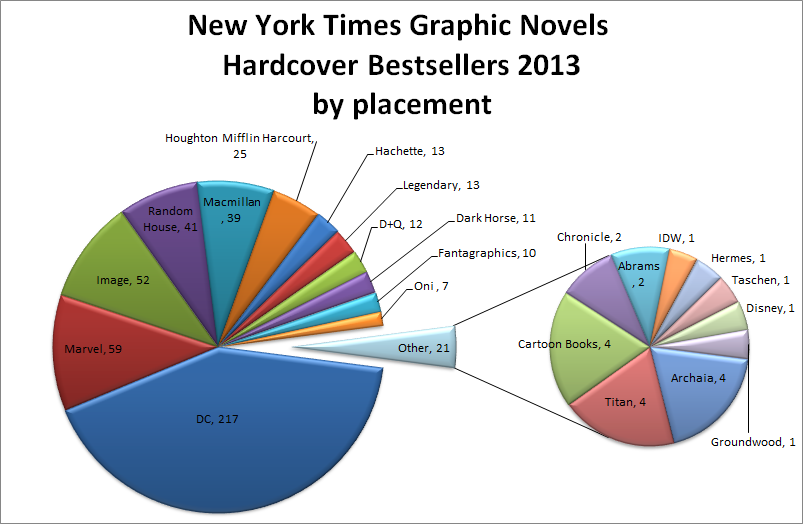
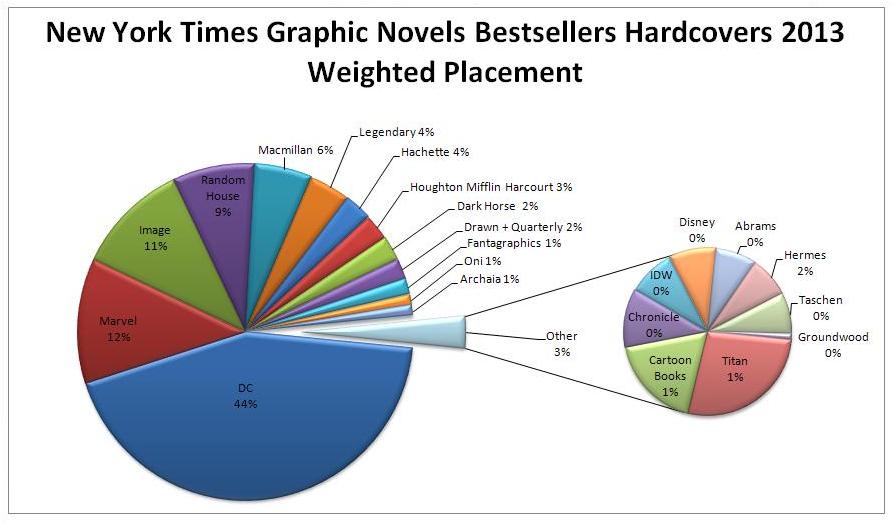
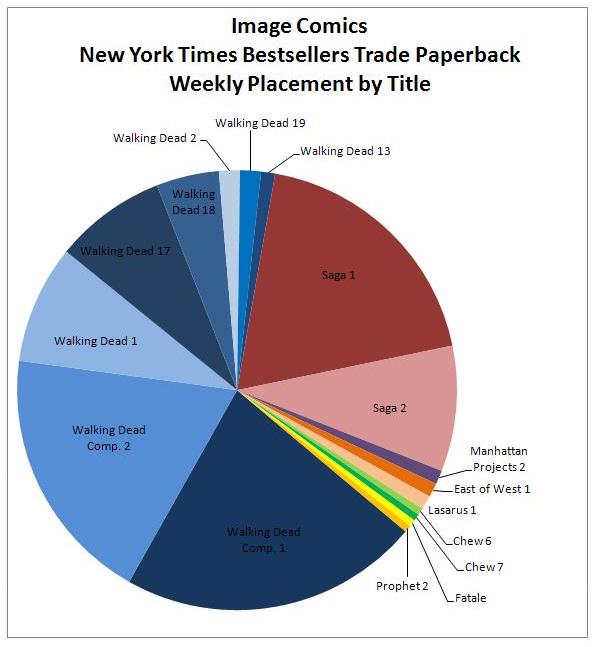
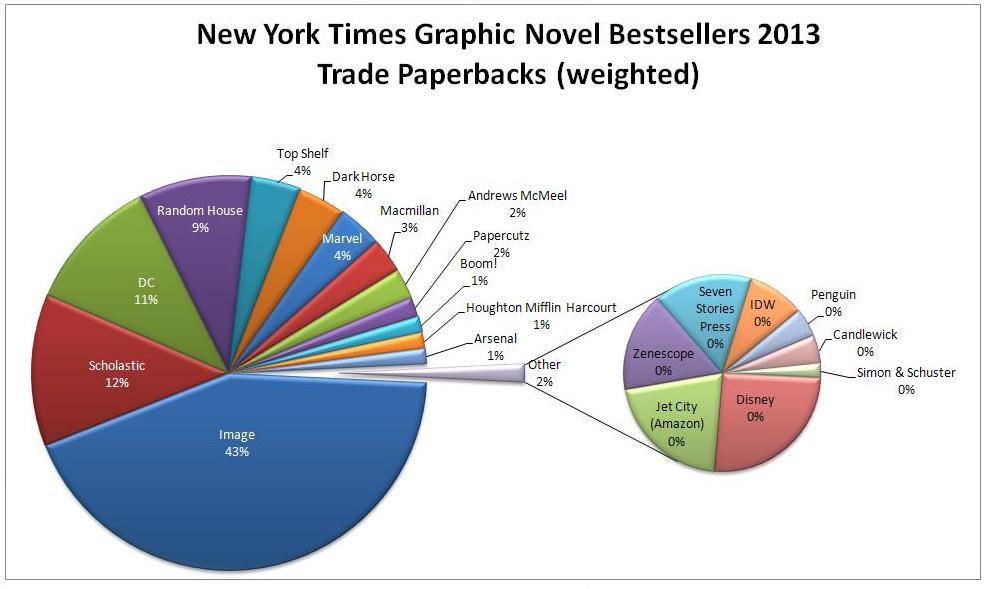
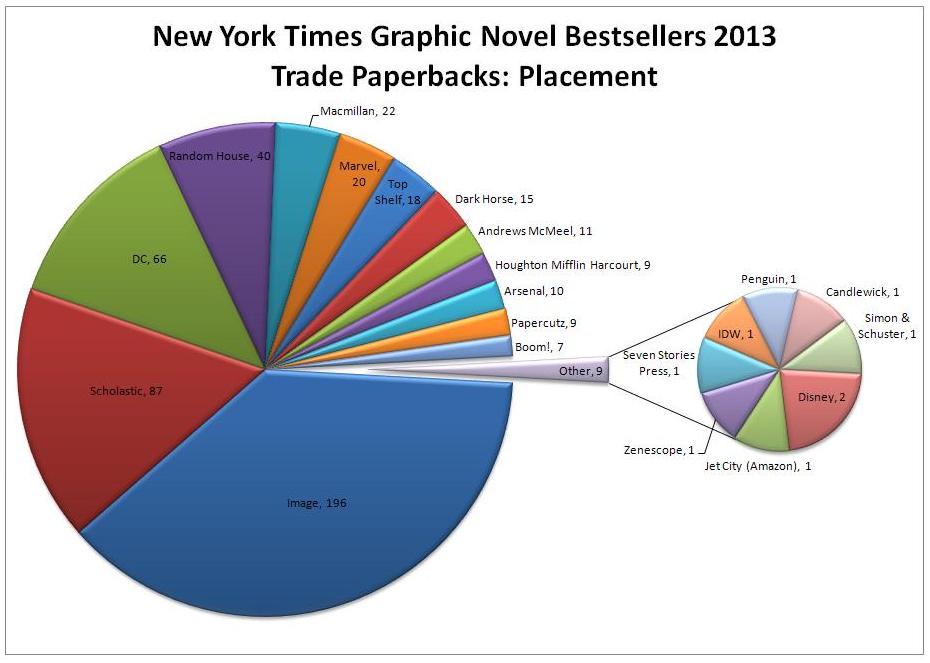
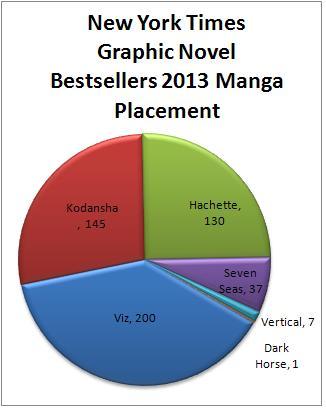
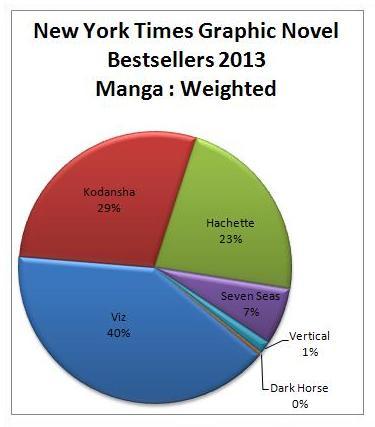
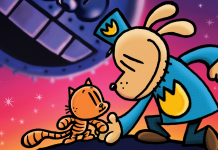




Avatar the Last Airbender is gone and has been replaced by the Legend of Kora which continues the story of the next avatar. I think the success of the Dark Horse material is that it fills in the gaps from the original series to the new one and are considered cannon.
Quick. Someone forward this to Marc Oliver Frisch, so that we can get his snarky commentary on how poorly DC is doing.
Is the overall pie getting bigger?
Comments are closed.